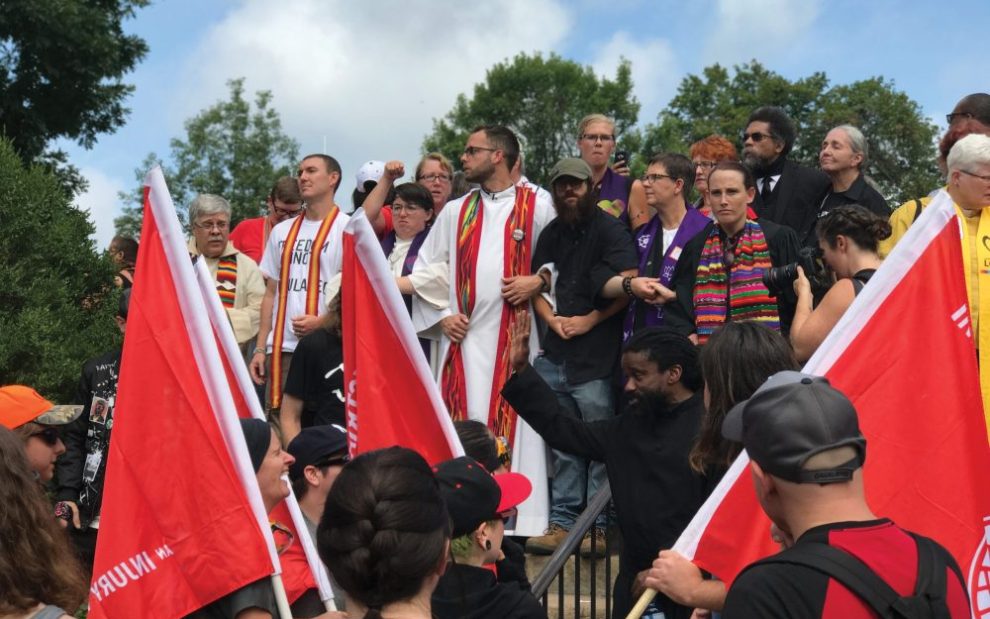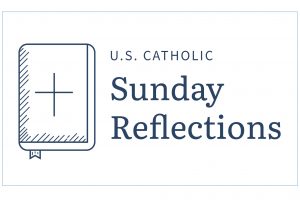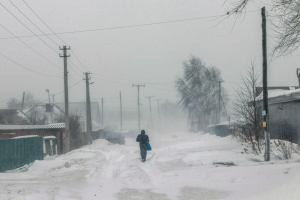On August 12, 2017, in Charlottesville, Virginia, right-wing hate groups gathered for a “Unite the Right” rally that turned violent and deadly. Present at the riot was a small but mighty group of anti-fascists resisting the white supremacy and fascism on display that day. Among them was a group of people of faith and clergy called Congregate Charlottesville, which had for weeks been training for nonviolent resistance leading up to “Unite the Right.”
Eric Martin, who teaches theology at Loyola Marymount University and the University of California, Los Angeles, was a member of the local Catholic Worker community, and he was part of Congregate Charlottesville in 2017. “It’s hard to describe what it’s like to know that armed Nazis with swastikas and Confederate flags are coming, intent on getting to the precise point that you are blocking, and that you’ve committed to nonviolence,” Martin writes in his book The Writing on the Wall: Signs of Faith Against Fascism (Wipf & Stock).
In The Writing on the Wall, Martin weaves together stories about the anti-fascist community in Charlottesville with biblical exegesis, theology, interviews, and art to explore what it means to “enflesh a worthy faith in the face of a fascist creep.”
Martin shows how an ethic of anti-fascism is an ethic of love that followers of Jesus are called to embody in the United States today. “Love cannot coexist with allowing fascist movements to grow,” he says.
Your book focuses on your experience in Charlottesville in 2017. Can you give an overview of what happened?
The so-called “summer of hate” in 2017 in Charlottesville all started because there’s a real legacy of white supremacy there. The town used to be majority enslaved. There was a city council meeting where a high schooler, Zyahna Bryant, proposed that we get rid of the Confederate statues that were prominently featured in town.
That got a lot of attention—it became this kind of call for white supremacists and the far right to come off the internet and coalesce here, ostensibly for the cause of saving these statues but really as a way to gather steam as a political movement. There were MAGA people, the Klan, Nazis, Confederates, and Proud Boys. The KKK rallied on July 8, 2017. And on August 12, 2017, at the “Unite the Right” rally, they ran a car through 20 people, murdering Heather Heyer. It was an act of mass terrorism in our town that all the authorities failed to stop.
I had just moved to Charlottesville and gotten involved with the Catholic Worker. Eventually, some people of faith came together to figure out how we wanted to act.
This group of people eventually became Congregate Charlottesville, which was created by Rev. Brittany “Smash” Caine-Conley and Rev. Seth Wispelwey. They also brought in Rev. Osagyefo Sekou to train people in nonviolence. On the day of August 12, 2017, Congregate Charlottesville was one of many groups out there trying to disrupt Unite the Right’s ability to organize, commit violence, recruit, and say their speeches on the news to look impressive.
I was also part of an anti-fascist house church called Charis, a beautiful, multifaceted space that the founder, Grace Aheron, called a “plot for the future.”
Can you define fascism and how it operates in the United States today?
There’s not a lot of agreement, even among people who study it. I choose to operate with two definitions in mind. One is from a historian named Robert Paxton, who in the English-speaking world is a sort of authoritative voice in fascist studies. He talks about fascism not so much as an ideology—it’s not this rational, coherent set of views—but as a set of mobilizing passions. Fascist movements tend to see themselves as a people of destiny who’ve been wronged by an impure population that’s diluted its greatness. They need to rise like a phoenix from the ashes and establish their peoplehood once again. And because there are people who are a threat to that, outsiders or insiders who are allies to the outsiders, there’s not just tolerance but a glorification of violence against those people as something that is necessary and good for the flourishing of that “destined” people.
Aimé Césaire, meanwhile, says fascism is basically colonization turned inward on itself, brought home. What was the Holocaust? Mass brutality and genocide. The same thing was happening in Africa and Asia and Latin America. The details are different, but it’s the same thing brought back to Europe.
For some contemporary anti-facist writers, the definition is important, but it’s more important to mobilize against anything that could even potentially be fascistic. So more important than getting a strict definition is making sure to protect anyone who’s vulnerable to fascistic violence.
What does it look like today? I think there’s the obvious—the spectacle. There’s Donald Trump. Robert Paxton, who’s a very careful academic, originally said no, Donald Trump is not a fascist. But after the January 6 insurrection, he revised his opinion and said, you know what, I’ve been studying fascism for decades. Now I can safely say Donald Trump has crossed the line; he’s a fascist. So there’s the loud stuff, the Steve Bannons and what’s happened recently in Nashville, with Patriot Front marching down the streets with Confederate flags. Recently, there was an article that came out about “The Base,” a neo-Nazi group created by a guy who went to Catholic school who’s now living in Russia. They’re saying that the election cycle is coming, and they need a leader in America. It’s like a job listing to become a neo-Nazi fascist mobilizer.
So that’s one aspect, the dramatic stuff. But I think that the spectacle can be very misleading if we stare at it. Paxton talks about how fascism depends on the everydayness of it, the functionaries. It’s the businesspeople, it’s the police state. That’s very much Aimé Césaire’s definition of colonialism brought home. Tanks rolling up on people praying for their own water supply at Standing Rock is an example.
Fascism looks like big, dramatic, electoral politics stuff, but it’s also just everyday—it’s kids being thrown into ICE detention centers for crossing the U.S.-Mexico border and the mass acceptance of it. In that sense, it’s not new, and it’s not unique to our electoral moment.
It’s also Confederate culture. Robert Paxton says the birth of fascism very well may have been the first KKK in 1866. The Nazis explicitly drew on laws and culture from the American South. So in that sense, Confederate culture is a very long continuation of fascist culture.
What is “fascist creep”?
It means we’re not in a sprint toward fascism; we’re in a creep. Although now I would call it a bit of a march in our country. There are subcultures taking root. Paxton talks about five stages of fascism—even if you can’t define fascism by an ideology, you can watch it happen in motion. The Nazis would be fifth-stage fascism, fully blown. But at the first stage, fascists are trying to establish some sort of place from which to grow.
Can you define anti-fascism and what that movement looks like?
Because there’s no universally agreed-upon definition of fascism, it’s hard to find a more easily agreed upon definition of anti-fascism, other than “that which opposes fascism.” When most people are talking about anti-fascism, they’re talking about revolutionary anti-fascism. Mark Bray, who wrote a book on anti-fascism, calls it pan-leftist politics.
More simply, I’ve heard it defined this way on the streets of Charlottesville: It’s a politics of love. How do we create communities of love such that there’s no space for fascism to grow and flourish? That’s the project of anti-fascism. But it’s not just what we’re opposing—we’re building societies and communities and little pockets of insurrectionary love, so that you’re playing offense against fascism, not defense. In that sense, it’s something deeply communal. That’s why I find it overlaps so easily with the gospels.
What do nonviolence and enemy love look like in a fascist creep?
I did my dissertation on Dan Berrigan, and he wrote these letters back and forth with Ernesto Cardenal, who was immersed in the Sandinista movement—the Nicaraguan freedom fighters fighting against the dictatorship with means that included counterviolence and offensives with weapons. Things that Dan Berrigan, who was committed to nonviolence, said were morally indefensible. He wrote something like: “You cannot carry both the gospel and a gun. You will eventually have to put one of them down.”
Cardenal disagreed with him, clearly. He was a part of the Sandinistas, and he worked in their government after they achieved their revolution. I remember reading these letters and agreeing with both. How do you hold a commitment to nonviolence while recognizing that, in some cases, insisting on nonviolent behavior might not be appropriate? For example, trying to control the actions of the Sandinistas, who are being oppressed by state power, might not be nonviolent. Sometimes, preaching nonviolence could unintentionally increase the likelihood that people accept violence against themselves.
I strive for nonviolence, to embody it. You only find these things out when it’s time to put it on the line, how committed you are. I aspire toward it. But when it comes to practice, reality is complex and messy, like the Bible. It’s not a cookie-cutter thing.
I love Gandhi’s nonviolent theory, but it’s not something you can just pull out and apply to the Nazis in 1944. It’s not something you can cut out and apply to America in 2024. You adapt it, you interpret it creatively and consciously, in the same way you would with anything, including our biblical texts. We, as people committed to nonviolence, should enflesh it without policing communities who are more vulnerable and who might not be wed to that.
Just because God, in Daniel 5, defaces state property in response to idolatry and ends up killing the king and toppling a military power, that doesn’t prescribe it for us in 2024. It just means that it’s part of the sacred drama we’ve inherited as divine. And you can’t discard that without losing something valuable in our own shared tradition.
I want to be wary of prescribing loving your enemies to other people who are more vulnerable, but for those who are committed to that, I think they should enflesh it, rather than telling vulnerable people to enflesh it. But you go love [your enemies] in a way that doesn’t enable their fascism but shrinks the space for it.
If you love a fascist, you want them to stop being a fascist and not be able to carry out the fascist plan. So loving your enemy in this case would have to mean confronting them, frustrating them, getting in their way. Stopping them out of love for your own community, for people who are vulnerable, but also ultimately out of love for them, too. There’s a biblical scene with Saul and David; even though one has been trying to kill the other, David spares him and calls him father. It’s like, someone’s trying to kill you, and you’re emphasizing your kinship with them. This call to deep love guides how I approach anti-fascism.
How do we ready our internal selves from the get-go? To whom do we extend our love, and how does that translate to action? Can we see those actions of confronting people on the streets as an act of love for them, as well as everyone else?
Are there moments in scripture you look to for sustenance in fighting fascism?
The Bible is a complex set of documents. Some of them are what Phyllis Trible would call texts of terror. Some of it could totally legitimize fascist movements. In fact, fascist movements often come with Bible quotes at the ready, understandably so.
So what do I look to? I look to Jesus’ stories. I look to him when he’s messy and uncivil, when he’s overturning tables and pissing people off and screaming at people who hold power in the streets and insulting them. Christians believe in a Messiah who was publicly insulting people, calling them broods of vipers and whitewashed sepulchers.
Jesus would have pissed people off today, respectable people. Christians should not shy away from that. I think it’s also important that it’s not just the aggressive Jesus who’s out there destroying property like in that scene in the Temple. I personally take a lot from Jesus walking with Nicodemus at night, talking with the Pharisee, the supposed enemy. To be able to reach across those lines and meet: I find that to be a sign of love, enemy love, on both of their parts. I find that very instructive for addressing fascism today.
You have a line in the book that says, “Christian love in a fascist creep requires subversion and destruction.” Can you say more about that?
When I say that love in a fascist creep means subversion and destruction, I mean we’ve got to destroy fascist cultures, in the same way Jesus was trying to destroy the space for demons to inhabit people.
Evil things should not flourish. That means destroying the idea that if the Proud Boys are going to have a rally, that you have to just leave them alone because that’s what civility calls for. No, we need to destroy this notion that the First Amendment means that we should let Nazis organize for genocide by inviting more people into their circles in their rallies.
In Charlottesville, that’s what we did. Communally, we destroyed their ability to talk. That’s why you didn’t see on Fox or CNN all these fascist speeches from Richard Spencer and these other people. No 12-year-old boys got to see these faces and voices on screen and think, oh, look at these manly men. Maybe I want to be like this and join them. That didn’t get to happen. Instead, they looked like a bunch of murderous people because that’s what they showed themselves to be. That’s because of the resistance in Charlottesville—the community did not let them speak.
In the book, you write about how, especially in Catholic spaces, there’s a lack of organized, sustained resistance to fascism. For Catholics who are concerned, where could they begin?
I would say two things: One is to act locally. It can be very overwhelming to think about things on a national scale, like how do we stop Project 2025? You probably can’t on your own. So start local. Find the people who are committed to love and justice and mercy and implement that in public. Discuss it, pray about it. Read the accounts of what happened in Charlottesville and Ferguson. Read about Portland Interfaith Clergy Resistance (PICR), an interfaith clergy group opposing fascists that’s led by a rabbi.
Rabbi Abraham Joshua Heschel was asked what he was doing marching in the civil rights movement. He said, “I’m praying with my feet.” I think Catholics can draw upon that—many Catholics already have—and continue to learn how to pray creatively in ways that are not the stereotypes and see opposing fascism as part of something that can be liturgical and prayerful.
I think there’s this image of opposing fascism, that it’s doing the most hardcore actions or nothing at all. But the vast majority of anti-fascist activity has nothing to do with confronting armed fascists in the streets. If you bake, feed the movement. If you write, publish something in a local outlet. If you teach, incorporate these things into the material. If you fold paper cranes, show the community how to fold paper cranes and make something beautiful together that you can bring with you to demonstrations. That’s what Grace Aheron did in Charlottesville. She even set up a nail-painting station at a protest.
Rather than think about what we have to learn to do, think about what we already know how to do and contribute to movements of justice and love with those gifts you already have. It doesn’t have to be intimidating or dangerous or heroic or dramatic. It’s just bringing yourself to join everyone else so we can all grow and learn and share together.
This article also appears in the November 2024 issue of U.S. Catholic (Vol. 89, No. 11, pages 16-21). Click here to subscribe to the magazine.
Image: Flickr.com/Anthony Crider, Eric Martin and other counterprotesters at the Unite the Right Rally in Charlottesville, 2017.












Add comment